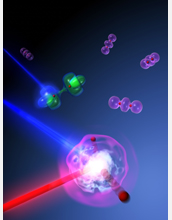Multimedia Gallery
Violent explosion of N2 molecule
A violent explosion of an N2 molecule after interaction with an X-ray beam results in the sudden loss of two electrons.
The Henry Kapteyn/Margaret Murnane group at JILA is working to develop both strong field ionization and high-harmonic generation (HHG) as powerful tools to capture the behavior of electrons and the evolution of molecular structure when molecules are exposed to strong laser fields. The group has observed that atoms and molecules have a universal response to strong laser fields. Part of the electron wave function undergoes tunnel ionization, a quantum mechanical phenomenon in which an electron passes through an energy barrier it otherwise could not surmount. The electron can later recombine with the parent ion. By monitoring this process, the group hopes to probe the evolution of electron orbitals and changes in the structure of the atomic nuclei inside a molecule.
The group is developing HHG for this and other projects. In HHG, the researchers harness attosecond laser pulses to manipulate electrons and generate bright beams of coherent X-rays. The process begins with the focusing of an intense femtosecond laser into a gas where an electron can literally be ripped from an atom or molecule as the laser suppresses the Coulomb barrier that binds the electron to the ion. Once released, the electrons oscillate in the light field, and some of them can coherently recombine with the same atom or molecule. The excess energy of the recombining electron is then emitted as an X-ray photon. This extreme nonlinear process results in the generation of coherent, laser-like beams of X-rays that emerge in bursts lasting from a few femtoseconds (10-15 s) to <100 attoseconds (10-18 s). HHG can be thought of as a coherent version of the original Roentgen X-ray tube.
JILA is a joint institute of the University of Colorado Boulder and the National Institute of Standards and Technology. You can learn more about research by the Kapteyn/Murnane group Here. (Date of Image: August 2007)
Credit: Greg Kuebler, JILA
Images and other media in the National Science Foundation Multimedia Gallery are available for use in print and electronic material by NSF employees, members of the media, university staff, teachers and the general public. All media in the gallery are intended for personal, educational and nonprofit/non-commercial use only.
Images credited to the National Science Foundation, a federal agency, are in the public domain. The images were created by employees of the United States Government as part of their official duties or prepared by contractors as "works for hire" for NSF. You may freely use NSF-credited images and, at your discretion, credit NSF with a "Courtesy: National Science Foundation" notation.
Additional information about general usage can be found in Conditions.
Also Available:
Download the high-resolution JPG version of the image. (1.4 MB)
Use your mouse to right-click (Mac users may need to Ctrl-click) the link above and choose the option that will save the file or target to your computer.

